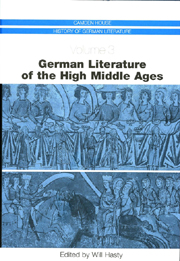Book contents
- Frontmatter
- Contents
- List of Illustrations
- Acknowledgments
- Introduction
- Part I The First Flourishing of German Literature
- Part II Lyric and Narrative Traditions
- Didactic Poetry
- Minnesang — The Medieval German Love Lyrics
- The German Heroic Narratives
- Early Mystical Writings
- Part III Continuity, Transformation, and Innovation in the Thirteenth Century
- Part IV Historical Perspectives
- Bibliography
- Notes on the Contributors
- Index
Minnesang — The Medieval German Love Lyrics
from Part II - Lyric and Narrative Traditions
Published online by Cambridge University Press: 05 February 2013
- Frontmatter
- Contents
- List of Illustrations
- Acknowledgments
- Introduction
- Part I The First Flourishing of German Literature
- Part II Lyric and Narrative Traditions
- Didactic Poetry
- Minnesang — The Medieval German Love Lyrics
- The German Heroic Narratives
- Early Mystical Writings
- Part III Continuity, Transformation, and Innovation in the Thirteenth Century
- Part IV Historical Perspectives
- Bibliography
- Notes on the Contributors
- Index
Summary
ONE OF THE EARLIEST VERNACULAR REFERENCES to love songs in Germany is contained in Von des tôdes gehugede (remembrance of death), a poem written ca. 1160 by a layman poet named Heinrich, who was associated with the monastery of Melk. The poem articulates the memento mori theme so common in religious and lay literature of the Middle Ages, by means of which one was brought to think of death and thus of the instability of life and all worldly things. In this poem, a beautiful woman is instructed to behold the decomposing corpse of a man who during his life was her lover. The effects of the ongoing decomposition are described with images that juxtapose the man's current physical state with his former happy life as a courtier, and also as a lyric poet, who praised “der frowen hôchvart” (The proud bearing of ladies). The specific reference to love songs is associated with the consideration of the man's tongue, “dâ mit er diu troutliet chunde / behagenlîchen singen” (with which he could sweetly sing songs of love), but which now lies motionless.
Heinrich's reference to love songs, besides its value in documenting the existence of a love song tradition during a time that preceded most of the love lyrics that have come down to us in written form, provides a sociocultural perspective from which to assess the significance of the emergence of Minnesang in the High Middle Ages.
- Type
- Chapter
- Information
- German Literature of the High Middle Ages , pp. 141 - 160Publisher: Boydell & BrewerPrint publication year: 2006



